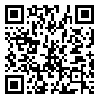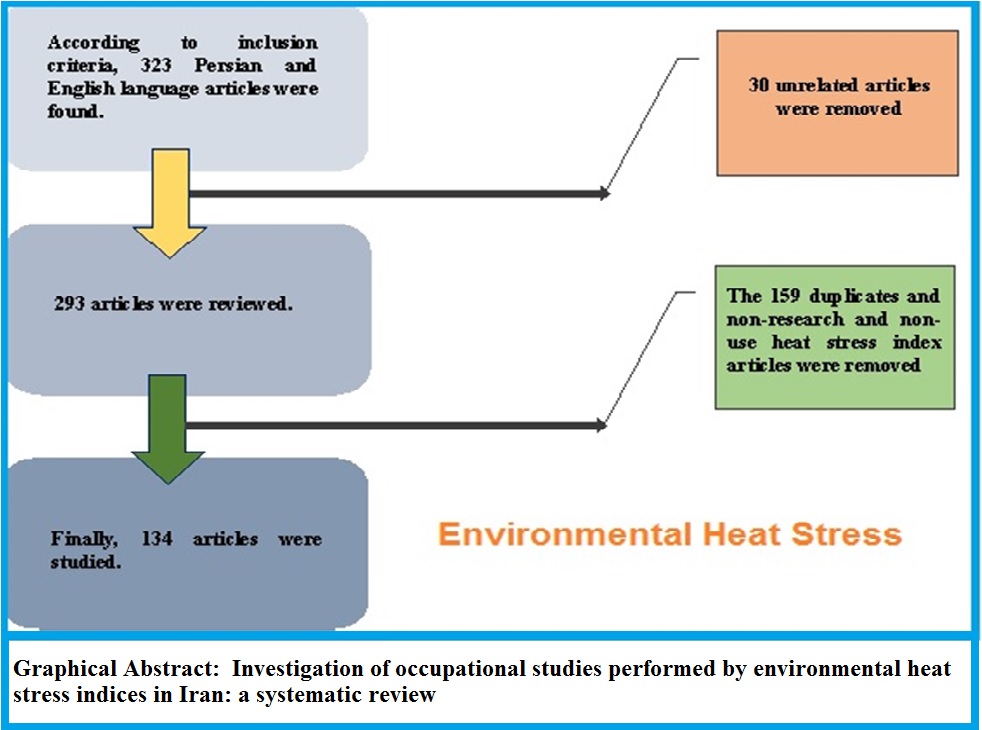Volume 9, Issue 4 (12-2019)
J Health Saf Work 2019, 9(4): 265-282 |
Back to browse issues page
Download citation:
BibTeX | RIS | EndNote | Medlars | ProCite | Reference Manager | RefWorks
Send citation to:



BibTeX | RIS | EndNote | Medlars | ProCite | Reference Manager | RefWorks
Send citation to:
Yazdanirad S, Kalantary S, Golbabaei F. Investigation of occupational studies performed by environmental heat stress indices in Iran: A systematic review. J Health Saf Work 2019; 9 (4) :265-282
URL: http://jhsw.tums.ac.ir/article-1-6213-en.html
URL: http://jhsw.tums.ac.ir/article-1-6213-en.html
1- School of health, Shahrekord University of medical sciences, Shahrekord, Iran | Department of Occupational Health Engineering, School of health, Tehran University of medical sciences, Tehran, Iran
2- Department of Occupational Health Engineering, School of health, Tehran University ofmedical sciences, Tehran, Iran
2- Department of Occupational Health Engineering, School of health, Tehran University ofmedical sciences, Tehran, Iran
Abstract: (3385 Views)
Introduction: Many studies, especially in recent years, have evaluated and controlled the occupational heat stress in Iran using environmental indices. However, so far, no comprehensive study has been conducted to review and classify these studies. Therefore, this study aimed to review and investigate the occupational studies performed by environmental heat stress indices in Iran.
Material and method: In the present study, the published articles from 2000 to 2016 were searched using Persian and English keywords including heat stress, heat strain, hot condition, warm condition, occupational health, thermal environment and Iran. Search of articles was performed in databases such as Web of Science, Google Scholar, PubMed, Scopus, Science Direct, SID, Magiran, Civilica, Iran Medex, Barakatkns and Irandoc. In total, 323 articles were found and 134 articles of them, based on the exclusion criteria, were selected and included in this study.
Results: Based on the results, most numbers of the studies, with 93.3 percent of the total researches related to published article, have been carried out between years of 2010 to 2016. As well as, most of studies with 61.9 percent were related to the indoor industrial environments. Most of studies were also performed in cities of Isfahan with 31.08 percent, Tehran with 16.89 percent, and Assaluyeh with 11.48 percent, respectively. As well as, WBGT index with 76 percent and the UTCI and PHS indices with 0.6 percent had the highest and lowest usage in all environments and industries, respectively. In addition, the results showed that WBGT index had most usage in industries of melting and casting with 15.7 percent, petroleum with 8.3 percent, and outdoor small occupations with 8.3 percent, respectively. Based on the results, the industries of the refinery, steel, glasswork, melting and casting, mines, and ship repairs have the highest mean values of WBGT index, respectively.
Conclusion: The results showed the need to more attention of researchers for conducting studies in outdoor environments, in different cities of Iran, on development and validation of novel heat stress indices, and on implementation and evaluation of control measures in the environments with high heat stress.
Material and method: In the present study, the published articles from 2000 to 2016 were searched using Persian and English keywords including heat stress, heat strain, hot condition, warm condition, occupational health, thermal environment and Iran. Search of articles was performed in databases such as Web of Science, Google Scholar, PubMed, Scopus, Science Direct, SID, Magiran, Civilica, Iran Medex, Barakatkns and Irandoc. In total, 323 articles were found and 134 articles of them, based on the exclusion criteria, were selected and included in this study.
Results: Based on the results, most numbers of the studies, with 93.3 percent of the total researches related to published article, have been carried out between years of 2010 to 2016. As well as, most of studies with 61.9 percent were related to the indoor industrial environments. Most of studies were also performed in cities of Isfahan with 31.08 percent, Tehran with 16.89 percent, and Assaluyeh with 11.48 percent, respectively. As well as, WBGT index with 76 percent and the UTCI and PHS indices with 0.6 percent had the highest and lowest usage in all environments and industries, respectively. In addition, the results showed that WBGT index had most usage in industries of melting and casting with 15.7 percent, petroleum with 8.3 percent, and outdoor small occupations with 8.3 percent, respectively. Based on the results, the industries of the refinery, steel, glasswork, melting and casting, mines, and ship repairs have the highest mean values of WBGT index, respectively.
Conclusion: The results showed the need to more attention of researchers for conducting studies in outdoor environments, in different cities of Iran, on development and validation of novel heat stress indices, and on implementation and evaluation of control measures in the environments with high heat stress.
Type of Study: Research |
Received: 2019/12/28 | Accepted: 2019/12/28 | Published: 2019/12/28
Received: 2019/12/28 | Accepted: 2019/12/28 | Published: 2019/12/28
| Rights and permissions | |
 |
This work is licensed under a Creative Commons Attribution-NonCommercial 4.0 International License. |






